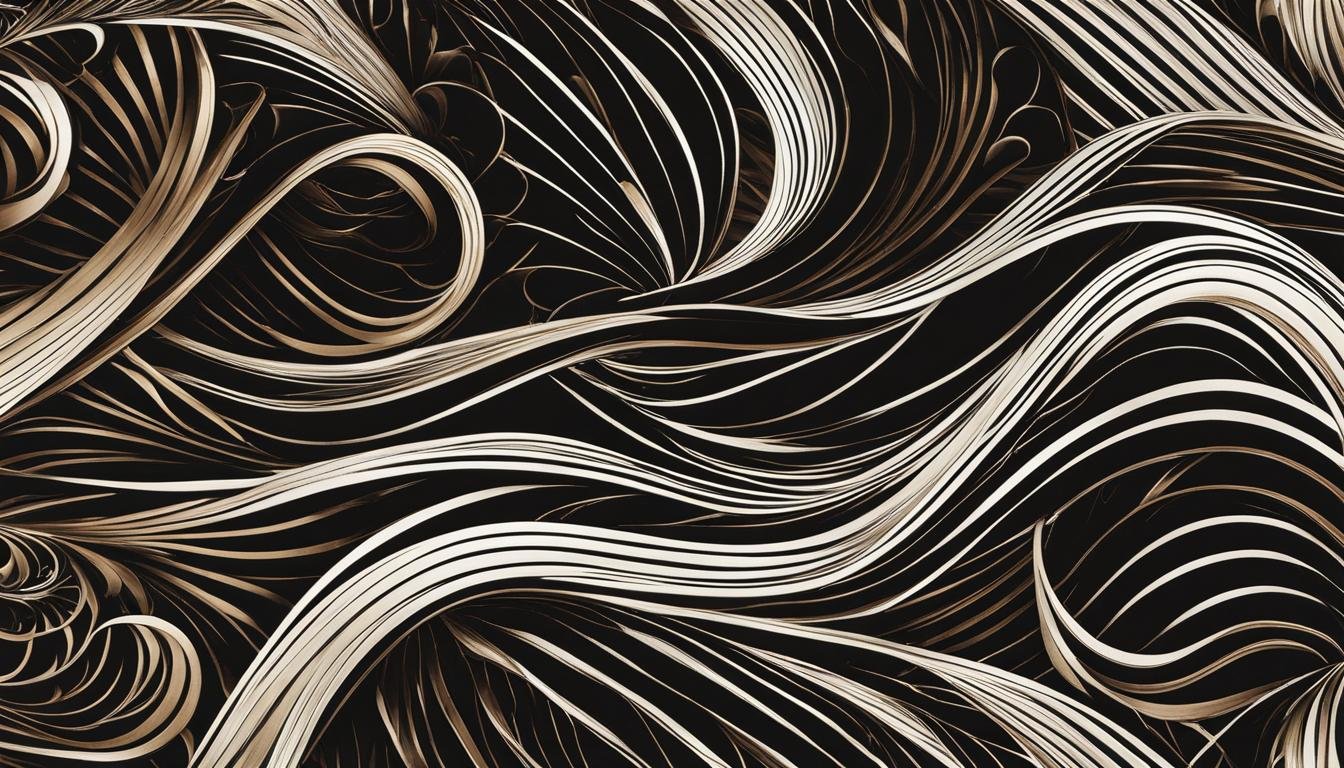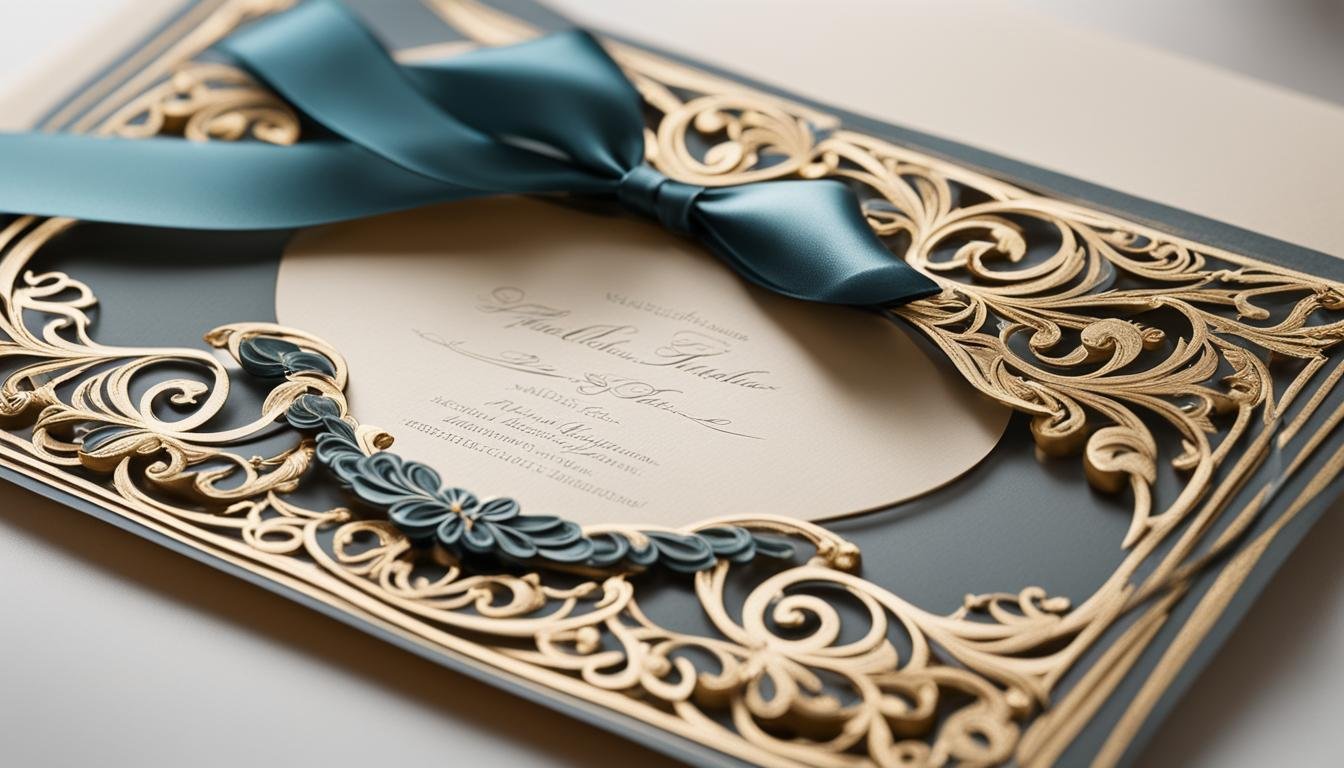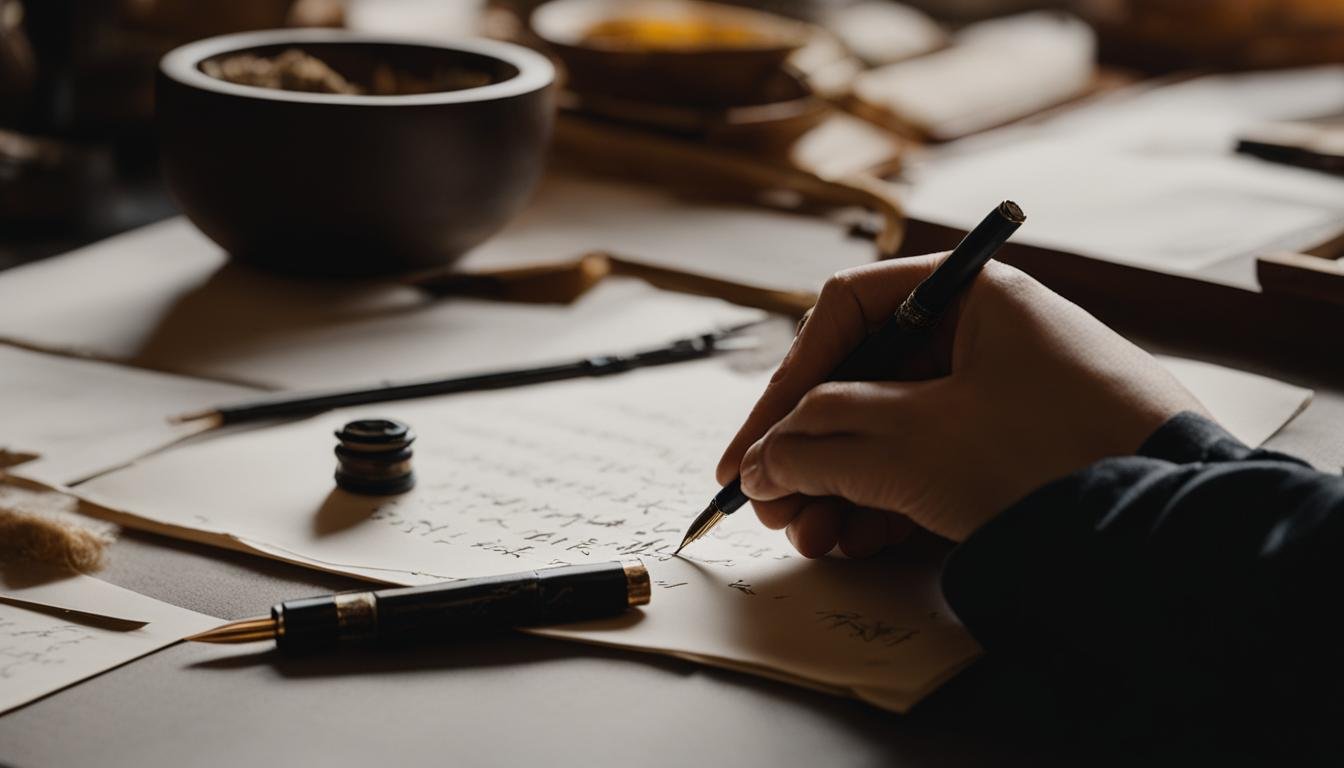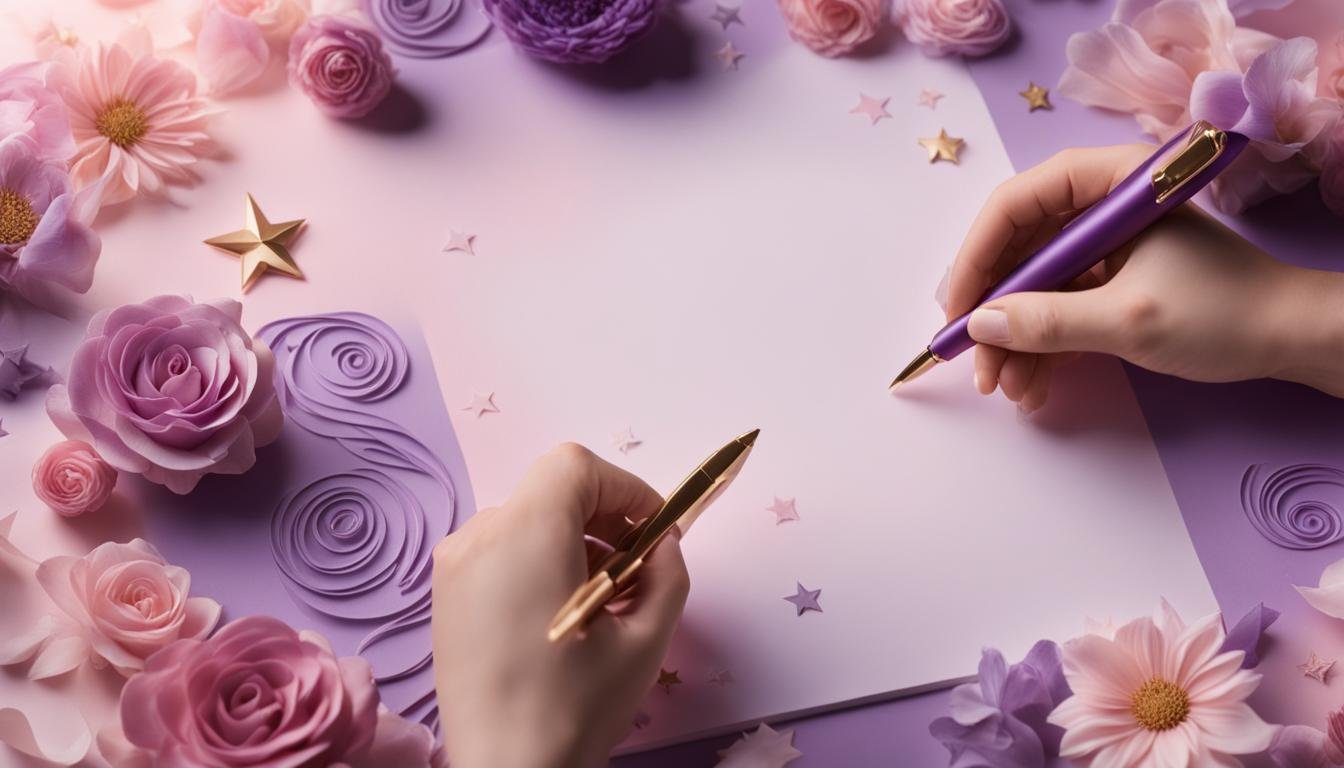Cursive Calligraphy Introduction: Master the Art of Elegant Writing Today!
Cursive Calligraphy Introduction! Welcome to the captivating world of cursive calligraphy, where elegant writing takes center stage. In this article, we will explore the art of transforming handwriting into a beautiful form of expression. Whether you are a beginner or seeking to refine your cursive skills, this guide will provide you with the essential knowledge to write in this graceful style.
Key Takeaways:
- Cursive calligraphy is a form of elegant writing that can elevate your handwritten expressions.
- Mastering cursive script requires an understanding of the basics, such as stroke flow and letter connections.
- Improving your cursive handwriting involves techniques like consistent letter slant and finding your optimal writing speed.
- Choosing the right tools, including pens with good ink flow and understanding pen pressure, is crucial for achieving beautiful cursive script.
- Regular practice and the use of practice sheets and exercises are essential for mastering cursive calligraphy.
The Basics of Cursive Script
In order to master the art of cursive calligraphy, it is essential to have a solid understanding of the basics of cursive script. Cursive writing is characterized by its flowing strokes and the seamless connection of letters. By understanding the fundamentals, such as stroke flow and letter connections, you can achieve a more elegant and cohesive cursive script.
When writing in cursive, the flow of strokes is crucial. Each letter is formed by a series of deliberate strokes that create a rhythmic and graceful script. It is important to practice the correct stroke flow for each letter to maintain consistency and improve your cursive writing skills.
The connection between letters is another key aspect of cursive script. Unlike print handwriting, where letters are often written separately, cursive writing requires letters to be connected, resulting in a continuous and fluid script. Learning how to connect each letter smoothly and naturally is essential for creating a coherent cursive script.
By mastering the basics of cursive script, including stroke flow and letter connections, you can lay a strong foundation for developing your cursive calligraphy skills. In the next section, we will explore the cursive calligraphy alphabet, focusing on the formation of lowercase letters.
Table: Cursive Script Basics
| Element | Description |
|---|---|
| Stroke Flow | The direction and sequence of strokes used to form each letter in cursive script. |
| Letter Connections | The seamless joining of letters in cursive writing to create a continuous and fluid script. |
| Consistency | The importance of maintaining consistent stroke flow and letter connections to achieve an elegant and cohesive cursive script. |
Cursive Calligraphy Alphabet: Lowercase Letters
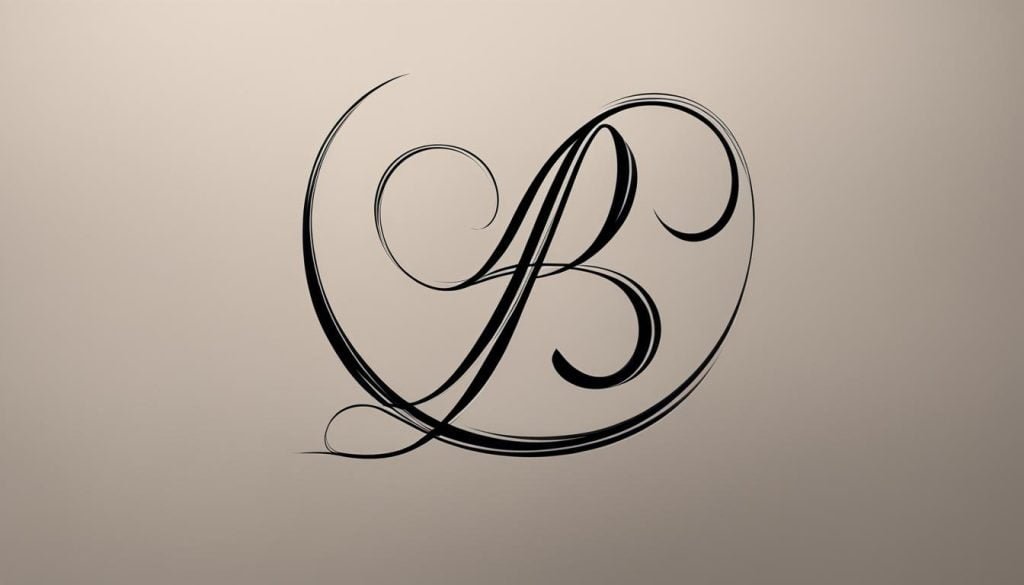
Mastering the art of cursive calligraphy begins with learning the lowercase letters. By understanding the formation of each letter, you can develop a fluid and elegant cursive script. Let’s explore the cursive calligraphy alphabet for lowercase letters to enhance your writing skills.
The key to mastering cursive letter formation lies in practicing the basic strokes and understanding the proper technique for each letter. With lowercase cursive letters, you’ll notice that many of them begin with an upward stroke. This creates the signature slant and graceful flow that cursive calligraphy is known for.
When writing in cursive, maintain a consistent letter slant, ensuring that each letter leans slightly to the right. This creates a visually appealing and cohesive script. Remember to give each letter enough space to breathe, allowing for clear distinction between letters.
Below is a table showcasing the cursive calligraphy alphabet for lowercase letters, along with the correct stroke order and direction for each letter. Practice writing these letters repeatedly to develop muscle memory and refine your cursive skills.
| Letter | Stroke Order | Example |
|---|---|---|
| a | 1. Upward stroke 2. Small loop to the left 3. Curve down and to the right 4. Cross in the middle |
|
| b | 1. Upward stroke 2. Loop to the right and down 3. Small loop to the left 4. Slant down and to the right |
|
| c | 1. Upward stroke 2. Curve to the right and down 3. Hook back to the left |
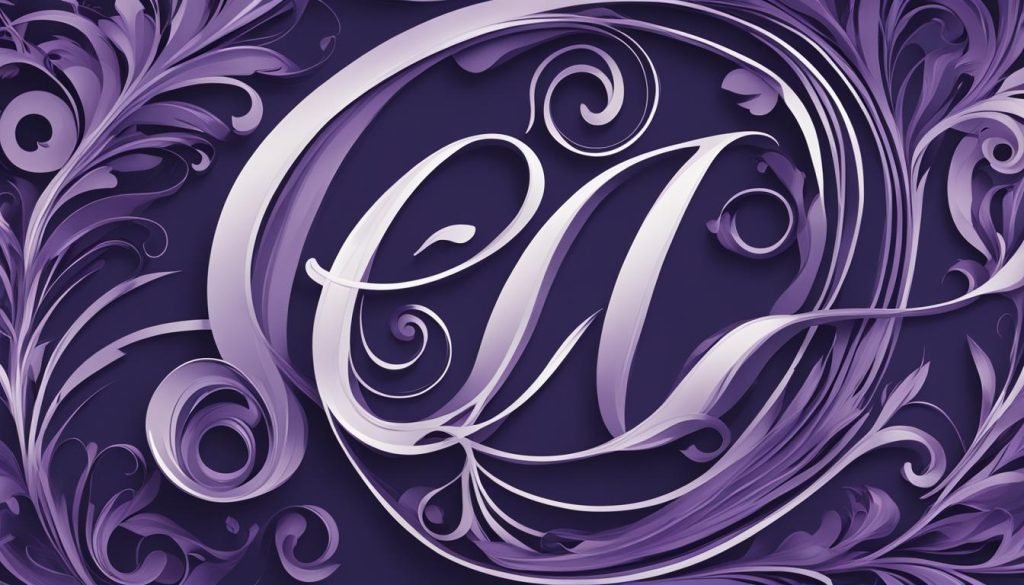 |
| d | 1. Upward stroke 2. Loop to the right and down 3. Pull back and slant down to the right |
Continue practicing the remaining lowercase letters of the cursive calligraphy alphabet, such as e, f, g, and so on. With consistent practice and attention to detail, you’ll soon be able to write in cursive with confidence and elegance.
Cursive Calligraphy Alphabet: Uppercase Letters
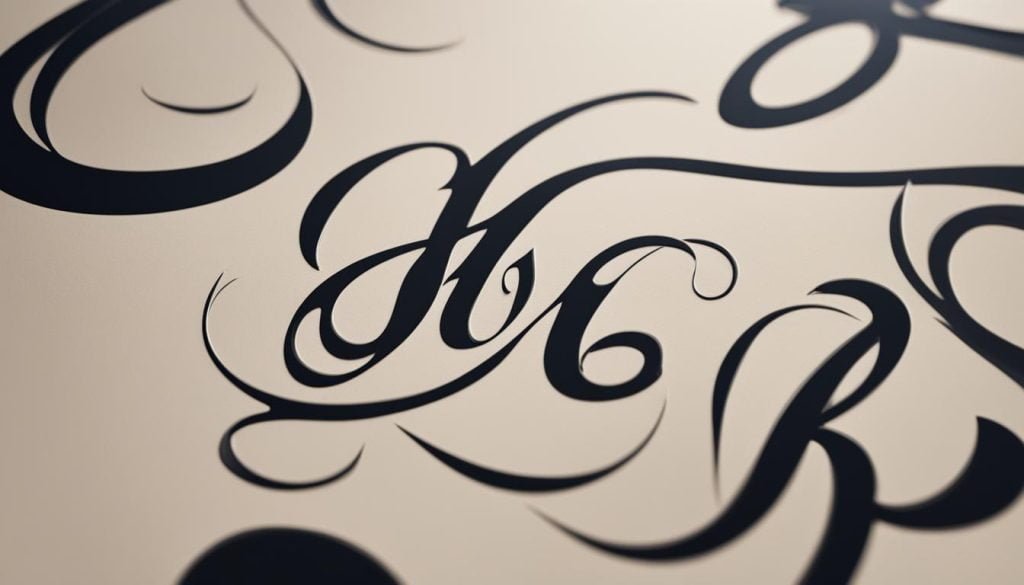
In cursive calligraphy, uppercase letters have their own unique flair and elegance. Mastering the formation of these uppercase letters will allow you to create stunning and sophisticated cursive script. Let’s explore the uppercase cursive calligraphy alphabet and learn how to write each letter with precision and style.
Uppercase Letter Formation
When writing uppercase letters in cursive, it’s important to pay attention to their distinct characteristics. Each letter has its own unique strokes and connections, which contribute to the overall aesthetics of your cursive script. Here is a guide to help you master the formation of uppercase cursive letters:
| Letter | Formation |
|---|---|
| A | Start with a short upward stroke, then create a curve that extends downward to the baseline. Lift the pen, move to the right, and create a slanted stroke towards the baseline. |
| B | Begin with a small loop at the top, then form a curve that goes downward and loops back up to the top. Extend a vertical stroke from the loop to the baseline. |
| C | Start with a short upward stroke, then create a curve that extends downward, looping back up slightly towards the baseline. |
| D | Begin with a small loop at the top, then create a curve that goes downward and loops back up to the top, extending a vertical stroke from the loop to the baseline. |
Continue practicing the formation of each uppercase letter, paying attention to the flow and connections between strokes. With time and practice, you will develop a confident and consistent style in your uppercase cursive calligraphy.
Remember to maintain a consistent slant and spacing between letters to ensure a harmonious appearance. Now that you have learned the formation of uppercase letters, you are one step closer to mastering the art of cursive calligraphy.
Tips for Improving Your Cursive Handwriting
If you’re looking to enhance the aesthetic quality of your cursive handwriting, here are some tips and techniques to help you improve:
- Find your optimal writing speed: Experiment with different writing speeds to find the pace that allows you to maintain consistency and control. Writing too fast can lead to sloppy letterforms, while writing too slowly can result in stiff and unnatural strokes.
- Use guidelines: To achieve consistent letter slant and spacing, consider using guidelines as a reference. Whether you’re using lined paper or creating your own guidelines, they can help guide the height and width of your letters for a more uniform cursive script.
- Rotate your paper: Rotating your paper slightly can provide a more comfortable wrist position and improve the flow of your cursive writing. Experiment with different angles to find the one that works best for you.
- Practice letter connectio
Choosing the Right Tools for Cursive Calligraphy
When it comes to cursive calligraphy, choosing the right tools is essential for achieving beautiful and elegant results. The right pen can make a significant difference in the flow and appearance of your cursive script. Here, we’ll explore different types of pens that are suitable for cursive writing and discuss the importance of ink flow and pen pressure.
One of the most popular choices for cursive calligraphy pens is the fountain pen. It provides a smooth and consistent ink flow, allowing for precise and graceful strokes. The fine nib of a fountain pen is ideal for creating thin and delicate lines, while a broader nib can add flair and variation to your cursive script. Experiment with different nib sizes to find the pen that suits your writing style.
In addition to fountain pens, there are also brush pens specifically designed for cursive calligraphy. These pens have a flexible tip that mimics the brush strokes of traditional calligraphy brushes. Brush pens allow for greater control and versatility, allowing you to create both fine and bold lines in your cursive script. They are a popular choice for those looking to achieve a more expressive and dynamic style of cursive calligraphy.
When using any type of pen for cursive calligraphy, it’s important to consider pen pressure. Applying the right amount of pressure can greatly affect the appearance of your script. Lighter pressure creates thinner and lighter strokes, while heavier pressure produces thicker and darker lines. Experiment with different levels of pen pressure to add depth and contrast to your cursive calligraphy.
Table: Comparison of Cursive Calligraphy Pens
| Pen Type | Features | Best For |
|---|---|---|
| Fountain Pen | Smooth ink flow, variety of nib sizes | Precise and elegant cursive script |
| Brush Pen | Flexible tip, allows for fine and bold lines | Expressive and dynamic cursive script |
| Italic Pen | Specifically designed for italic cursive script | Italic style calligraphy |
| Parallel Pen | Flat nib, creates consistent line width | Uniform and smooth cursive script |
Table: Comparison of Cursive Calligraphy Pens
Ultimately, the choice of pen for cursive calligraphy is a personal preference. Each pen type offers its own unique features and characteristics, allowing you to explore different styles and techniques in your cursive writing. Experimentation is key to finding the pen that feels most comfortable in your hand and produces the desired effect in your cursive calligraphy.
Mastering Cursive Calligraphy: Practice Sheets and Exercises
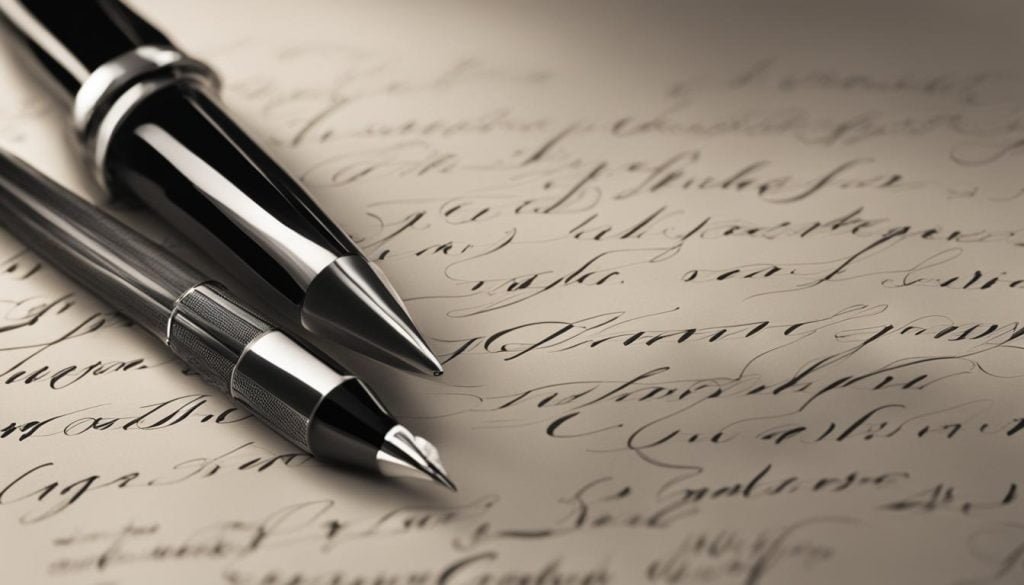
Practicing regularly is essential for mastering cursive calligraphy. To help you develop and refine your cursive skills, we have created a variety of practice sheets and exercises. These resources will guide you through drills for individual letters as well as full cursive alphabets, allowing you to enhance your letter formation, stroke flow, and overall consistency.
Our cursive practice sheets contain guided lines and examples, providing a foundation for practicing each letter of the alphabet. By following the strokes and guidelines, you can train your hand and eye coordination, gradually improving the fluidity of your cursive script.
In addition to practice sheets, we offer cursive handwriting drills that target specific areas of improvement. These drills focus on common challenges such as letter slant, spacing, and connecting letters smoothly. By dedicating time to these exercises, you can address specific areas of weakness and enhance the overall quality of your cursive writing.
| Resource | Description |
|---|---|
| Cursive Practice Sheets | Printable sheets with guided lines and examples for each letter of the alphabet. |
| Cursive Handwriting Drills | Targeted exercises to improve specific aspects of cursive writing, such as letter slant and letter connection. |
| Cursive Script Guides | Detailed guides on cursive letter formation and stroke flow, providing step-by-step instructions for each letter. |
Remember, consistency and regular practice are key to mastering cursive calligraphy. Use these practice sheets and exercises to refine your skills and unlock the beauty of elegant cursive writing.
Exploring Elegant Cursive Styles
When it comes to cursive calligraphy, there are various elegant styles that you can explore to add a touch of sophistication to your writing. Two popular styles are traditional cursive calligraphy and italic cursive calligraphy.
Traditional cursive calligraphy is characterized by its flowing, rounded letters with subtle flourishes. This style exudes a classic and timeless elegance, making it a popular choice for formal invitations, certificates, and other important documents.
Italic cursive calligraphy, on the other hand, combines the slanted letterforms of italic handwriting with the fluidity of cursive script. This style is often used for artistic purposes, such as decorative lettering, quotes, and personal projects. Italic cursive calligraphy allows for more variation in letterforms and encourages creative experimentation.
To incorporate these elegant cursive styles into your writing, practice the letterforms with a focus on maintaining consistency in spacing, slant, and overall shape. Experiment with different pen nibs and ink colors to further enhance the visual appeal of your cursive script. Whether you choose to embrace the traditional elegance of cursive calligraphy or explore the artistic possibilities of italic cursive, these styles are sure to elevate your writing to new heights.
| Traditional Cursive Calligraphy | Italic Cursive Calligraphy | |
|---|---|---|
| Characteristics | Flowing, rounded letters | Combination of italic and cursive letterforms |
| Use | Formal invitations, certificates, important documents | Decorative lettering, quotes, personal projects |
| Focus | Consistency in spacing, slant, and shape | Creative experimentation and variation |
Applying Cursive Calligraphy in Art and Design
One of the most captivating aspects of cursive calligraphy is its versatility in art and design. Whether you’re a professional artist or a hobbyist, incorporating cursive script into your creations can enhance their visual appeal and evoke a sense of elegance. From hand-lettered artwork to digital designs, cursive calligraphy adds a touch of sophistication. Let’s explore how cursive calligraphy can be applied in various art and design projects.
Hand-Lettered Artwork
Cursive calligraphy lends itself beautifully to hand-lettered artwork. Whether you’re creating personalized quotes, wedding invitations, or wall art, cursive script can elevate the overall aesthetic. With its graceful curves and flowing strokes, cursive calligraphy allows you to express your creativity and add a unique touch to your artwork. From delicate flourishes to bold lettering, the possibilities are endless.
Digital Design
In the digital age, cursive calligraphy has found a new platform for expression. From designing logos to crafting social media graphics, cursive script can bring a sense of elegance to your digital designs. Whether you’re creating a website or designing an advertisement, incorporating cursive calligraphy can help capture attention and convey a message of sophistication. With the right typography and layout, cursive script can enhance the overall visual impact of your digital creations.
Cursive Lettering Art
Lettering enthusiasts and calligraphers often explore different styles of cursive script to create stunning lettering art. From modern calligraphy with a twist to traditional copperplate script, cursive lettering art showcases the beauty of hand-drawn letters. Whether you’re creating artwork for journals, greeting cards, or illustrations, experimenting with cursive calligraphy styles can add depth and character to your lettering compositions.
| Cursive Calligraphy in Art and Design | Applications |
|---|---|
| Hand-Lettered Artwork | Personalized quotes, wedding invitations, wall art |
| Digital Design | Logos, social media graphics, website design |
| Cursive Lettering Art | Journals, greeting cards, illustrations |
Whether you’re an artist, designer, or simply someone who appreciates the beauty of cursive calligraphy, incorporating this elegant writing style in your art and design projects can add a touch of sophistication. From hand-lettered artwork to digital designs and cursive lettering art, cursive calligraphy offers endless possibilities for creative expression. Explore different applications and let the graceful curves and flowing strokes of cursive script enhance your art and design endeavors.
Cursive Calligraphy for Special Occasions
When it comes to special occasions, adding a touch of elegance and sophistication can make all the difference. Cursive calligraphy is the perfect choice for invitations, greeting cards, and wedding designs, creating a beautiful and personalized touch. Whether you’re planning a wedding, a birthday celebration, or sending a heartfelt message, cursive script adds a unique charm to your special moments.
For invitations, cursive calligraphy brings a sense of refinement and style. The flowing lines and graceful curves of cursive script create an enchanting invitation design that sets the tone for your event. Whether it’s a formal black-tie affair or a whimsical garden party, cursive calligraphy adds a touch of class and elegance to your invitation suite.
Greeting cards are another occasion where cursive script shines. Whether you’re expressing your love and gratitude or sending a heartfelt message, cursive calligraphy adds a personal and artistic touch to your words. From birthdays and anniversaries to holidays and special occasions, the delicate strokes of cursive letters convey warmth and sincerity.
| Occasion | Examples |
|---|---|
| Weddings | Invitation suites, place cards, wedding vows |
| Birthdays | Personalized greeting cards, birthday invitations |
| Anniversaries | Customized anniversary cards, love letters |
| Holidays | Festive cards, holiday party invitations |
“Cursive calligraphy adds a touch of elegance and charm to any special occasion. It’s a timeless art form that beautifully complements the sentiment behind invitations, greeting cards, and wedding designs.” – Calligraphy expert
When it comes to weddings, cursive calligraphy takes center stage. From the save-the-dates to the wedding vows, cursive script creates a romantic and sophisticated atmosphere. Whether you choose to have your wedding invitations hand-lettered or opt for printed calligraphy fonts, cursive script sets the tone for your big day.
So, whether it’s an intimate gathering or a grand celebration, consider incorporating cursive calligraphy into your special occasions. From invitations to greeting cards and everything in between, let the art of cursive script add a touch of elegance and beauty to your cherished moments.
Conclusion – Cursive Calligraphy Introduction
In conclusion, cursive calligraphy offers a world of possibilities for personal projects. Whether you’re creating handmade cards, writing personal letters, or adding a special touch to your journaling, cursive calligraphy adds elegance and style to your work. By incorporating the techniques and tips discussed in this article, you can take your cursive handwriting to the next level.
If you’re looking to further enhance your cursive calligraphy skills, consider attending cursive calligraphy workshops. These workshops provide valuable hands-on experience and guidance from experienced calligraphers. You’ll have the opportunity to practice different cursive styles, learn advanced techniques, and receive personalized feedback to help you refine your craft.
For those who prefer self-paced learning, there are also a wealth of cursive calligraphy tutorials available online. These tutorials offer step-by-step instructions, practice exercises, and helpful tips to help you improve your cursive handwriting at your own pace. Whether you’re a beginner or an experienced calligrapher, these tutorials can be a valuable resource on your cursive calligraphy journey.
So, unleash your creativity and explore the world of cursive calligraphy. Whether you’re embarking on a personal project or looking to enhance your artistic skills, cursive calligraphy is a beautiful and versatile art form that will elevate your writing and bring your ideas to life.
FAQ – Cursive Calligraphy Introduction
What is cursive calligraphy?
Cursive calligraphy is a form of elegant writing that transforms handwriting into a beautiful script. It emphasizes the flow of strokes and the art of connecting letters to create a cohesive and fluid script.
What are the basics of cursive script?
The basics of cursive script include understanding the fundamental strokes, the flow of strokes in cursive writing, and the importance of connecting letters to achieve a cohesive and fluid cursive script.
How do I write lowercase cursive calligraphy letters?
Writing lowercase cursive letters involves learning the formation of each letter. It is important to practice writing them to enhance your cursive skills.
How do I write uppercase cursive calligraphy letters?
Writing uppercase cursive letters involves learning the formation of each letter and emphasizing the unique characteristics of uppercase cursive script.
How can I improve my cursive handwriting?
To improve your cursive handwriting, you can try finding your optimal writing speed, using guidelines and rotating your paper, and practicing regularly to enhance the aesthetic quality of your cursive script.
What tools should I use for cursive calligraphy?
Selecting the right tools is essential for achieving beautiful cursive calligraphy. You can use different types of pens suitable for cursive writing, pay attention to ink flow, and understand how pen pressure can affect the appearance of your cursive script.
How can I practice cursive calligraphy?
Practicing regularly is key to mastering cursive calligraphy. You can use practice sheets and exercises to help you develop your cursive skills, including drills for individual letters and full cursive alphabets.
What are some elegant cursive styles?
There are various elegant cursive styles, such as traditional cursive calligraphy and italic cursive calligraphy. Each style has unique characteristics that can be incorporated into your cursive writing.
How can I apply cursive calligraphy in art and design?
Cursive calligraphy can be applied in various art and design projects, including art, lettering, digital design, and branding. It adds a touch of elegance and sophistication to these mediums.
How can I use cursive calligraphy for special occasions?
Cursive calligraphy is perfect for adding elegance to special occasions. You can incorporate it into invitation designs, greeting cards, and wedding calligraphy to create a personalized and stunning touch.
Where can I find additional resources for cursive calligraphy?
To further explore cursive calligraphy, you can find additional resources such as cursive calligraphy workshops and tutorials. These resources can provide in-depth guidance and support for your cursive journey.

